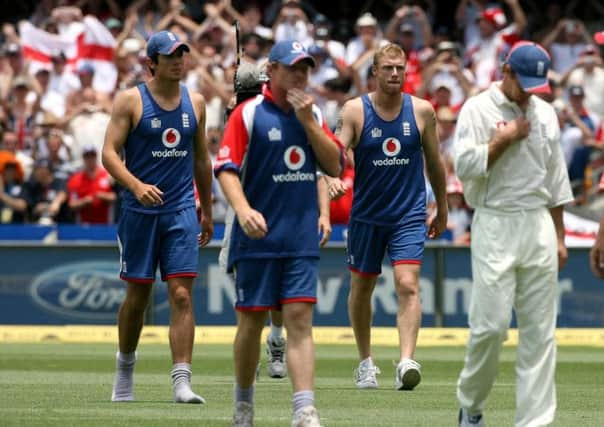Nightmare in Brisbane evokes memories of a crushing defeat of Flintoff’s men which sparked woeful series


Yes, seven years ago and the start of the 2006-07 series, when England were similarly swatted aside as Australia began a dominant winter that ended in a 5-0 series win.
England’s preparation for that series was far from perfect; in-fact, it was abysmal.
Advertisement
Hide AdAdvertisement
Hide AdAshes-winning captain and Yorkshire icon, Michael Vaughan, missed the entire 2006 season due to his long standing knee injuries and was not fit to lead the English challenge Down Under.
This left one of England’s talismanic players to take up the mantle as captain, Andrew Flintoff, who himself had only played one first-class game in the build-up to the series and was generally under an enormous amount of pressure.
Add to that the problematic ankle injury that was preventing him from bowling 100 per cent for long spells.
The early signs would make even the most optimistic and patriotic of English cricket fans feel a little bit worried and they would have every right to feel that way.
Advertisement
Hide AdAdvertisement
Hide AdEngland’s first warm-up match would prove to be a disaster, former Yorkshire overseas player, Phil Jaques. crunching 112 off only 109 deliveries as the Prime Minister’s XI amassed 347 for 5 off 50 overs. England’s reply would be a feeble 181 all out, only Andrew Strauss getting a respectable score.
Jaques would go on to torment England’s pace attack in the first innings of the second warm-up match, this time scoring 107 of New South Wales’ 355. However, England’s batting would have a lot more purpose to it, four players scoring over 50 as some thought the England of 2005 may have been bubbling beneath the surface, ready to break through possibly in time for the first Test in Brisbane.
England had one more warm-up match in between the New South Wales fixture and the first Test and that came against South Australia in Adelaide.
There was one notable omission on the England team sheet, that of experienced opening batsman Marcus Trescothick, arguably Flintoff’s man to turn to for advice. Trescothick had gone home suffering from stress related problems, leaving England with even more woes.
Advertisement
Hide AdAdvertisement
Hide AdThe first Test match started, with English fans getting the buzz back as the Barmy Army rolled into Brisbane.
One of the major questions was: could Australia’s wounded heroes face up to England’s pace attack? They didn’t have to wait long for the answer.
Steve Harmison, England’s in-form pace bowler, charged in, but delivered the ball to the hands of best friend Andrew Flintoff, who was stood at second slip.
From then on, the tone was set for the series; Harmison never looked the same player, his first innings figures reading 1-123 and his aggressive fight gone.
Advertisement
Hide AdAdvertisement
Hide Ad“From the very first ball of the Ashes I hated the game of cricket,” said Harmison.
“I can’t think of a worse ball to bowl than that. In fact, I can’t remember ever bowling a ball as bad as that.”
For the Baggy Greens, Ricky Ponting would go on to churn out 196 in the first innings, while Glenn McGrath, playing in his last-ever Test series, would take six scalps in England’s 155 all out, Ian Bell the only batsman to reach 50.
Australia’s second innings would go on to show the gulf between the two sides, Langer and Ponting combining again to take Australia’s score to 202-1.
Advertisement
Hide AdAdvertisement
Hide AdThis left England with the unenviable task of chasing 647, the previous highest successful run chase in Test cricket being 418.
Paul Collingwood and Kevin Pietersen both got into the nervous nineties, before falling short of 100s. England would go on to lose the first Test by an all mighty 277 runs.
This was just the start.
The second Test saw Collingwood and Pietersen combine again, this time Collingwood would score his Test-best score of 206, while Pietersen would contribute 158.
Unfortunately for England, Ricky Ponting would be the thorn in their side once more, scoring 142, while current Australia captain Michael Clarke battled his way to 124, but this still saw England have a lead of 38, the first time in the series that they had been ahead of the Australians.
Advertisement
Hide AdAdvertisement
Hide AdEngland faltered to 129 all out and allowed the Australians to steal the Test away and take a 2-0 lead.
The third Test would see England bowl Australia out cheaply for 244 but let them off the hook twice, scoring only 215 in reply, then allowing the Australians to score 527, Adam Gilchrist being one of three to score a century, his coming off 59 deliveries, just short of being the quickest-ever in Test history.
The fourth and fifth Tests saw no fight come from the English side, instead the hosts ran out clear winners on both occasions.
England are a lot more resilient bunch, one would hope, nowadays. But after being humiliated inside four days, it is hard not to think back to that sobering series seven years ago.